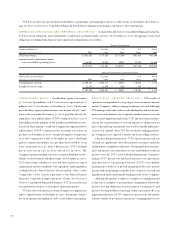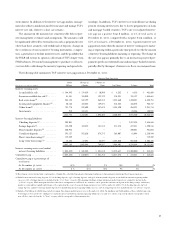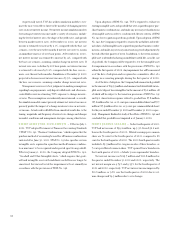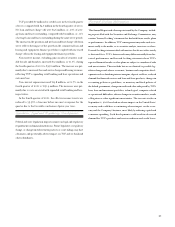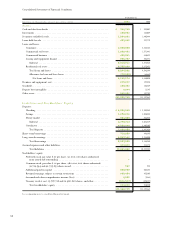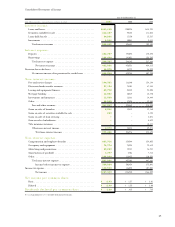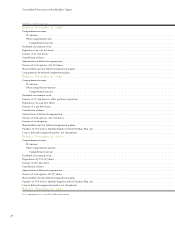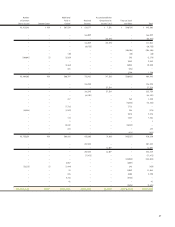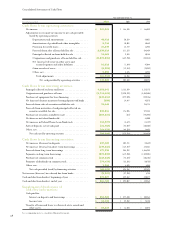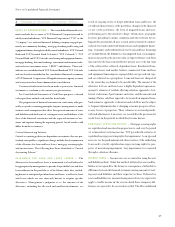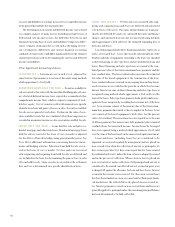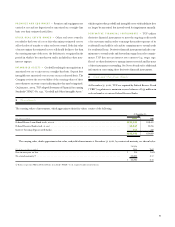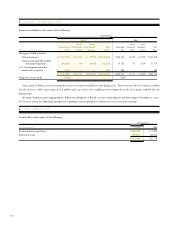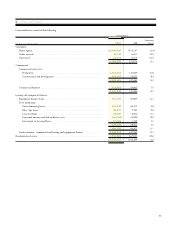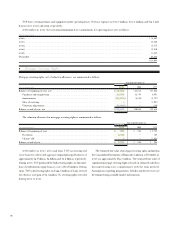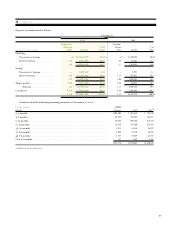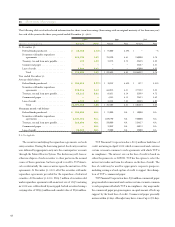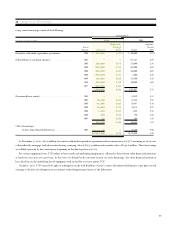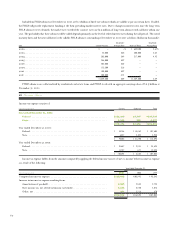TCF Bank 2001 Annual Report Download - page 52
Download and view the complete annual report
Please find page 52 of the 2001 TCF Bank annual report below. You can navigate through the pages in the report by either clicking on the pages listed below, or by using the keyword search tool below to find specific information within the annual report.
50
tax assets and liabilities of a change in tax rates is recognized in income
in the period that includes the enactment date.
The determination of current and deferred income taxes is based
on complex analyses of many factors including interpretation of
Federal and state income tax laws, the difference between tax and
financial reporting basis of assets and liabilities (temporary differ-
ences), estimates of amounts due or owed such as the timing of rever-
sals of temporary differences and current financial accounting
standards. Actual results could differ significantly from the estimates
and interpretations used in determining the current and deferred
income tax liabilities.
Other Significant Accounting Policies
INVESTMENTS – Investments are carried at cost, adjusted for
amortization of premiums or accretion of discounts using methods
which approximate a level yield.
SECURITIES AVAILABLE FOR SALE – Securities available for
sale are carried at fair value with the unrealized holding gains or losses,
net of related deferred income taxes, reported as accumulated other
comprehensive income (loss), which is a separate component of stock-
holders’ equity. Cost of securities sold is determined on a specific
identification basis and gains or losses on sales of securities available
for sale are recognized at trade dates. Declines in the value of secu-
rities available for sale that are considered other than temporary are
recorded in noninterest income as a loss on securities available for sale.
LOANS HELD FOR SALE – Loans held for sale include resi-
dential mortgage and education loans. Residential mortgage loans
held for sale are carried at the lower of cost or market as adjusted
for the effects of fair value hedges using quoted market prices. See
Note 18 for additional information concerning derivative instru-
ments and hedging activities. Education loans held for sale are car-
ried at the lower of cost or market. Net fees and costs associated
with originating and acquiring loans held for sale are deferred and
are included in the basis for determining the gain or loss on sales
of loans held for sale. Gains on sales are recorded at the settlement
date and cost is determined on a specific identification basis.
LOANS AND LEASES – Net fees and costs associated with origi-
nating and acquiring loans and leases are deferred and amortized
over the lives of the assets. Discounts and premiums on loans pur-
chased, net deferred fees and costs, unearned discounts and finance
charges, and unearned lease income are amortized using methods
which approximate a level yield over the estimated remaining lives of
the loans and leases.
Lease financings include direct financing and sales-type leases as
well as a leveraged lease. Leases that transfer substantially all of the
benefits and risks of equipment ownership to the lessee are classified
as direct financing or sales-type leases and are included in loans and
leases. Direct financing and sales-type leases are carried at the com-
bined present value of the future minimum lease payments and the
lease residual value. The lease residual value represents the estimated
fair value of the leased equipment at the termination of the lease.
Lease residual values are reviewed on an ongoing basis and any down-
ward revisions are recorded in the periods in which they become
known. Interest income on direct financing and sales-type leases is
recognized using methods which approximate a level yield over the
term of the leases. Sales-type leases generate dealer profit which is rec-
ognized at lease inception by recording lease revenue net of the lease
cost. Lease revenue consists of the present value of the future mini-
mum lease payments discounted at the rate implicit in the lease. Lease
cost consists of the leased equipment’s book value, less the present
value of its residual. The investment in a leveraged lease is the sum
of all lease payments (less nonrecourse debt payments) plus estimated
residual values, less unearned income. Income from the leveraged
lease is recognized using a method which approximates a level yield
over the term of the lease based on the unrecovered equity investment.
Loans and leases, including loans that are considered to be
impaired, are reviewed regularly by management and are placed on
non-accrual status when the collection of interest or principal is 90
days or more past due (150 days or more past due for loans secured
by residential real estate), unless the loan or lease is adequately secured
and in the process of collection. When a loan or lease is placed on
non-accrual status, unless collection of all principal and interest is
considered to be assured, uncollected interest accrued in prior years
is charged off against the allowance for loan and lease losses. Interest
accrued in the current year is reversed. For those non-accrual leases
that have been funded on a non-recourse basis by third-party finan-
cial institutions, the related debt is also placed on non-accrual sta-
tus. Interest payments received on non-accrual loans and leases are
generally applied to principal unless the remaining principal balance
has been determined to be fully collectible.


